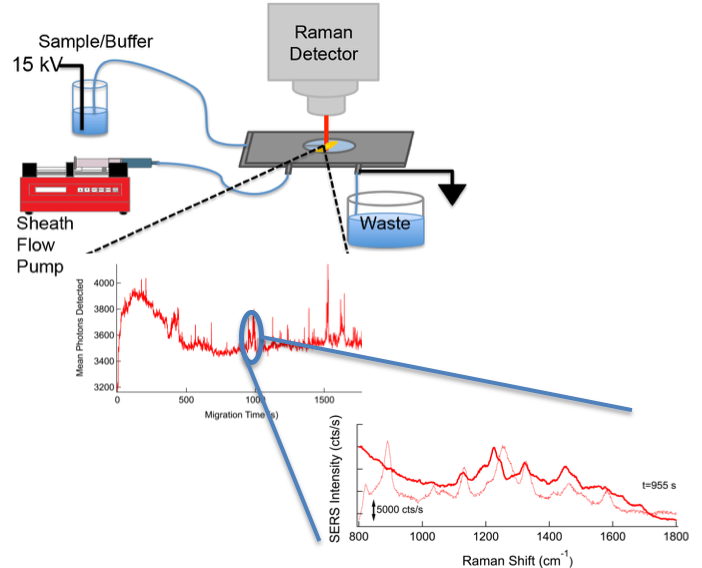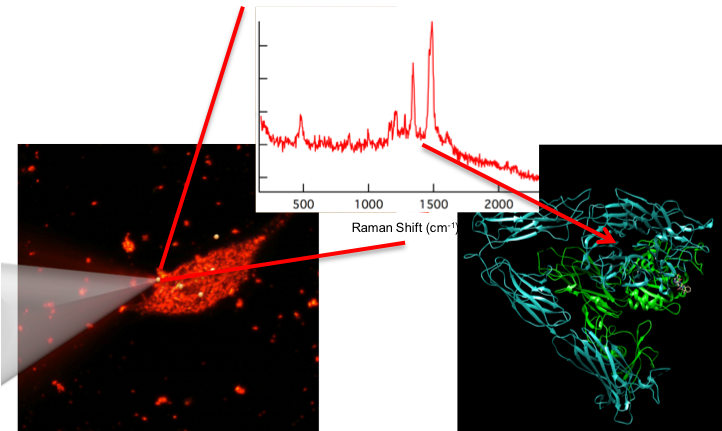In the Schultz Lab, we believe the new scientific breakthroughs will be enabled by state of the art chemical measurement. Our research focuses on developing new tools for identifying molecules relevant to biomedical diagnostics and other applications. To do this, we build and develop instrumentation that takes advantage of chemical properties to characterize complex samples. The interaction between lasers and molecules provides unique information for detecting and identifying the components in complex systems. Understanding the basic science involved in chemical detection and manipulating these interactions has led to breakthrough technologies with tremendous potential. We are actively pursuing problems in metabolomics, protein receptor signaling, and active plasmonics.
METABOLOMICS. The ability to specifically identify and quantify the 40,000+ metabolites in the human body is essential for a systems biology approach to health care. Changes in biochemical pathways can be distinguished provided enough intermediate molecules can be monitored accurately. Current technologies can identify about 20% of the in biological samples. Our lab invented (US Patent 9804093B2) and is developing sheath-flow surface enhanced Raman scattering, which uses the unique pattern of scattered light associated with the structure of molecules, to improve molecular identification. We combine Raman detection with capillary electrophoresis, liquid chromatography and other techniques. This methodology is orthogonal to existing technologies and should extend coverage of number of detectable metabolites.

References for further reading:
- Lifu Xiao; Chuanqi Wang; Chen Dai; Laurie Littlepage; Jun Li; Zachary Schultz*, Untargeted Tumor Metabolomics with Liquid Chromatography—Surface-Enhanced Raman Spectroscopy. Angewandte Chemie Int. Ed. 2020, 59 (9), 3439-3443, DOI: 10.1002/anie.201912387
- Nguyen, A. and Schultz, Z.D.* “Quantitative Online Sheath-flow Surface Enhanced Raman Spectroscopy Detection for Liquid Chromatography”, Analyst, 2016, 141(12), 3630-3635, DOI: 10.1039/C6AN00155F.
- Riordan, C.M., Jacobs, K.T., Negri, P., and Schultz, Z.D.*, “High Throughput Chemical Profiling in Urine by SERS”, Faraday Discussions, 2016, 187, 473-484, DOI: 10.1039/C5FD00155B.
- Bailey, M.R., Pentecost, A.M., Selimovic, A., Martin, R.S., Schultz, Z. D.*, “A Sheath-Flow Microfluidic Approach for combined SERS & Electrochemical Detection”, Analytical Chemistry, 2015, 87(8), 4347-4355, DOI: 10.1021/acs.analchem.5b00075.
- Negri, P., Flaherty, R.J., Dada, O.O., Schultz, Z.D.*, “Ultrasensitive Online SERS Detection of Structural Isomers Separated by Capillary Zone Electrophoresis”, Chemical Communications, 2014, 50(21), 2707-2710, DOI: 10.1039/C3CC49030K.
- Negri, P., Jacobs, K.T., Dada, O.O., Schultz, Z.D.*, “Ultrasensitive SERS Flow Detector Using Hydrodynamic Focusing” Analytical Chemistry, 2013, 85(21), 10159-10166 DOI: 10.1021/ac401537k.
PROTEIN RECEPTOR SIGNALING. Proteins on the surface and embedded with cellular membranes are key to communicating environmental signals to the machinery within cells, and are thus often drug targets. The ability to study the interaction of small molecules with receptors is a significant scientific challenge. By combining nanomaterials and state of the art spectroscopy and microscopy techniques, such as atomic force microscopy and tip-enhanced Raman scattering (TERS), we are able to monitor chemical signals associated with molecules interacting with specific proteins in intact cells. Understanding how molecules interact with signaling proteins offers promise to improve drug targeting as well as further investigate the role of membrane proteins in disease.

References for further reading:
- Sloan-Dennison, S.; Schultz, Z. D., “Label-Free Plasmonic Nanostar Probes to Illuminate In Vitro Membrane Receptor Recognition.” Chemical Science 2019, 10 (6), 1807-1815. DOI: 10.1039/C8SC05035J.
- Sloan-Dennison, S.; Bevins, M. R.; Scarpitti, B. T.; Sauvé, V. K.; Schultz, Z. D.*, Protein corona-resistant SERS tags for live cell detection of integrin receptors. Analyst 2019, 44 (18), 5538-5546. DOI: 10.1039/C9AN01056D.
- Kim, J, Zeng, Z., Xiao, L., and Schultz, Z.D.*, “Elucidating Protein- Ligand Recognition with Combined Surface Plasmon Resonance and Surface Enhanced Raman Spectroscopy”, Analytical Chemistry, 2017, 89(24), 13074-13081, DOI: 10.1021/acs.analchem.7b04246.
- Xiao, L., Bailey, K.A., Wang, H., and Schultz, Z.D.*, “Probing Membrane Receptor – Ligand Specificity with Tip Enhanced Raman Scattering”, Analytical Chemistry, 2017, 89(17), 9091-9099, DOI: 10.1021/acs.analchem.7b01796.
- Xiao, L., Wang, H., and Schultz, Z.D.* “Selective Detection of RGD-Integrin Binding in Cancer Cells Using Tip Enhanced Raman Scattering Microscopy”, Analytical Chemistry, 2016, 88(12), 6547-6553, DOI: 10.1021/acs.analchem.6b01344.
ACTIVE PLASMONICS. Underlying all the problems we investigate is the basic science relevant to the signal enhancements incorporated into our measurements. We are interested in understanding how nanomaterials interact with light, particularly with respect to how these properties alter the response from nearby molecules. This basic science serves as the basis for the development of future measurement techniques and other applications, such as photo-catalysts.

References for further reading:
- Nelson, D.A. and Schultz, Z.D.*, “Impact of Plasmon Induced Optically Rectified Electric Fields On Second Harmonic Generation.” Journal of Physical Chemistry C 2019, 123 (33), 20639-20648. DOI: 10.1021/acs.jpcc.9b05685.
- Nelson, D.A. and Schultz, Z.D.*, “Influence of Optically Rectified Electric Fields on the Plasmonic Photocatalysis of 4-Nitrothiophenol and 4-Aminothiophenol to 4,4-Dimercaptoazobenzene”, Journal of Physical Chemistry C, 2018, 122(15), 8581-8588, DOI: 10.1021/acs.jpcc.8b00662.
- Zeng, Z., Wang, H., Johns, P., Hartland, G.V., and Schultz, Z.D.*, “Photothermal Microscopy of Coupled Nanostructures and the Impact of Nanoscale Heating in Surface Enhanced Raman Spectroscopy”, Journal of Physical Chemistry C, 2017, 121(21), 11623-44631, DOI: 10.1021/acs.jpcc.7b01220.
- Wang, H., Yao, K., Parkhill, J.A.*, and Schultz, Z.D.* “Detection of electron tunneling across plasmonic nanoparticle-film junctions using nitrile vibrations”, Physical Chemistry Chemical Physics, 2017, 19(8), 5786-5796, DOI: 10.1039/C6CP08168A.
- Kwasnieski, D.T.; Wang, H.; Schultz, Z.D.*, “Alkyl-Nitrile Adlayers as Probes of Plasmonically Induced Electric Fields.” Chemical Science, 2015.6(8), 4484 – 4494, DOI: 10.1039/C5SC01265A.
- Marr, J.M., Schultz, Z.D.*, “Imaging Electric Fields in SERS and TERS Using the Vibrational Stark Effect” J. Physical Chemistry Letters, 2013, 4(19), 3268-3272, DOI: 10.1021/jz401551u.
SUPPORT. Our Research has been supported by the following entities:
